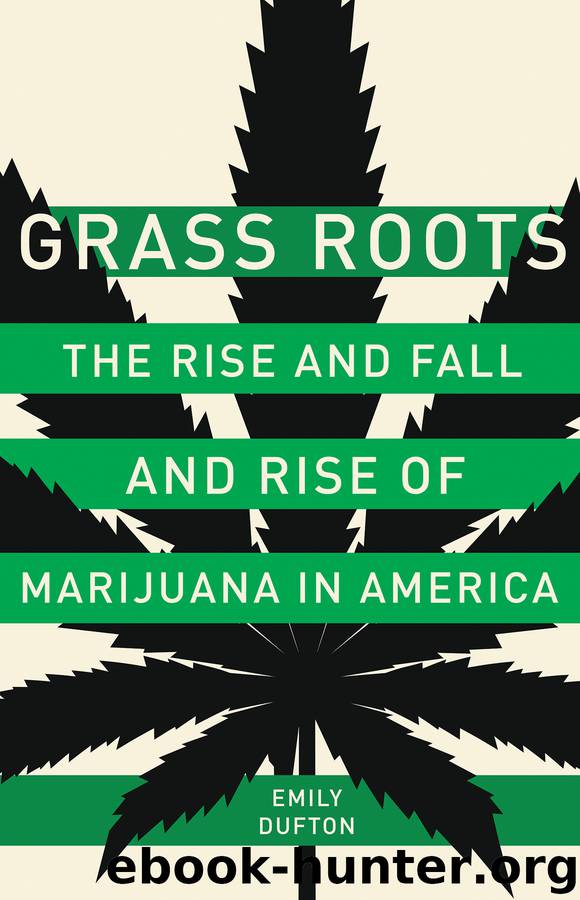Grass Roots by Emily Dufton

Author:Emily Dufton
Language: eng
Format: epub
Publisher: Basic Books
Published: 2017-12-05T05:00:00+00:00
There was a certain irony to the first lady’s remarks about embattled parents and the new logo’s declaration of an “American Crisis.” Throughout 1982 and into 1983, rates of adolescent use of all drugs rapidly declined; by 1983, rates of adolescent marijuana use were at their lowest in recorded history. The University of Michigan’s annual survey report announced that high school seniors’ daily use of marijuana had continued to drop during the first two years of the Reagan administration, decreasing from 7 percent in 1981 to 5.5 percent in 1983, while the use of amphetamines, barbiturates, and LSD had dropped markedly as well. The report’s authors celebrated these “substantial declines” and argued that they were “an encouraging sign that the downturn, which began in the past couple of years, is real and continuing.”26
Yet even as rates of use dropped, politicians, researchers, and the national media continued to declare that adolescent drug abuse was nothing less than a national crisis and that volunteer activism was the country’s only solution. Writing in Ladies’ Home Journal in January 1983, Nancy Reagan decried the “epidemic among our nation’s youth” that had destroyed so many lives. “Drug addiction is the most democratic of problems,” Reagan wrote. “It crosses all social, political, color and economic lines, and celebrities’ kids are every bit as vulnerable as ghetto children.” But, Reagan concluded, there were solutions to the problem: forming a local parent group, counteracting peer pressure, and even writing to the White House for a list of parent groups. “I’d like to ask everyone—parents as well as students—to get involved,” Reagan wrote. “If we close ranks, pull together and share our love and concern, nothing can stop us!”27
Leaders of the parent movement also had a vested interest in keeping the battle against adolescent drug use alive. Whereas once they were laughed out of federal offices, by 1983 social science researchers and government officials were lauding parent groups as the most important development in drug abuse prevention in decades. NIDA’s associate director for policy development and implementation, R. A. Lindblad, declared that, with the formation of the NFP, “the visible, vocal, contemporary [parent] movement was born. It has spread, not as a fad, but as an organized and committed response to the drug problems of the United States.”28 And in answer to the question posed by their article in the Journal of Primary Prevention, “Parent Groups in Drug Abuse Prevention: Is This the Constituency We’ve Been Waiting For?” the mental health researchers Anne Penney and Emily Garfield argued at length for “yes.”29 If their battle had only been against marijuana, parent activists would have already won. Instead, unwilling to give up the recognition they had worked years to achieve or to abandon their increasingly respected work, parent leaders joined the first lady in continuing to declare that the war on drugs was an essential battle. Their war on marijuana, out of necessity, had evolved.
By autumn of that year, the first lady and leaders of the NFP opened a new front in their battle against drug abuse: television.
Download
This site does not store any files on its server. We only index and link to content provided by other sites. Please contact the content providers to delete copyright contents if any and email us, we'll remove relevant links or contents immediately.
| Africa | Americas |
| Arctic & Antarctica | Asia |
| Australia & Oceania | Europe |
| Middle East | Russia |
| United States | World |
| Ancient Civilizations | Military |
| Historical Study & Educational Resources |
Cat's cradle by Kurt Vonnegut(15189)
Pimp by Iceberg Slim(14397)
4 3 2 1: A Novel by Paul Auster(12289)
Underground: A Human History of the Worlds Beneath Our Feet by Will Hunt(12026)
The Radium Girls by Kate Moore(11927)
Wiseguy by Nicholas Pileggi(5674)
Perfect Rhythm by Jae(5326)
American History Stories, Volume III (Yesterday's Classics) by Pratt Mara L(5257)
The Fire Next Time by James Baldwin(5250)
Paper Towns by Green John(5092)
Pale Blue Dot by Carl Sagan(4913)
A Higher Loyalty: Truth, Lies, and Leadership by James Comey(4846)
The Mayflower and the Pilgrims' New World by Nathaniel Philbrick(4428)
The Doomsday Machine by Daniel Ellsberg(4419)
Killers of the Flower Moon: The Osage Murders and the Birth of the FBI by David Grann(4387)
The Sympathizer by Viet Thanh Nguyen(4307)
Too Much and Not the Mood by Durga Chew-Bose(4276)
The Borden Murders by Sarah Miller(4248)
Sticky Fingers by Joe Hagan(4103)
